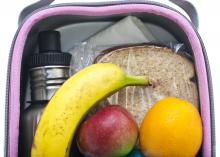Information Possibly Outdated
The information presented on this page was originally released on July 17, 2015. It may not be outdated, but please search our site for more current information. If you plan to quote or reference this information in a publication, please check with the Extension specialist or author before proceeding.
Fulfill taste preferences in a balanced lunchbox
STARKVILLE, Miss. -- Packing a balanced school lunch that kids like requires one skill: observation.
Brent Fountain, nutritionist with the Mississippi State University Extension Service, recommended that parents recognize what their children like eating the most at home.
“See what your child eats on a regular basis and take note of the most preferred foods,” Fountain said. “Some parents may want to have a quick fix when packing a lunch, but taste is not a one-size-fits-all scenario. Invest time in finding out what your child’s favorite foods are and how many of those are possible to incorporate into a lunch.”
Observation is just as important at the grocery store. Fountain said each of the five major food groups -- fruits, vegetables, dairy products, proteins and grains -- should be represented in the lunchbox. When picking out what foods to buy based on preferences and balance, look at the nutritional facts on each label and be wary of pre-packaged foods or meats that are overloaded with fats or sugars.
“Pre-packaged food, such as a small pack of crackers and cheese, can be an option,” he said. “Natural fats and sugars are fine, but going with a sandwich meat that may have a lot of saturated fat could be counterproductive. Look at the amount of total fat, but also look for saturated fat. If you compare saturated to total, and it’s high, you want to avoid it.”
Fountain also said comparing packaging of similar food products side by side can assist parents in packing the healthiest varieties of foods available while also keeping the child’s preferences in mind.
“When you see carbohydrates on the label, you’ll see total carbohydrates, but also the amount of fiber in a serving,” he said. “The more fiber, the better. If the number of added sugars appears high, you may want to find a product that is more reasonable.”
Alma Harris, Extension home economist in Washington County, said peanut butter provides necessary proteins and serves as a meat substitute.
“Putting peanut butter on crackers or an apple can also break up the monotony of the traditional peanut butter-and-jelly sandwich,” Harris said.
Harris said food safety is important to remember for parents who pack foods that must be kept cool and are not safe to eat at room temperature.
“Particularly for liquids, if you’re packing a juice box or a milk, you have to put an ice pack in the box,” Harris said. “If you’re packing soup, it should be in an insulated container such as a thermos.”
Fountain added that cafeterias sell low- and no-fat varieties of milk. Packing water to drink on some days and juice on others can keep children from becoming bored with the same thing, but sodas should be avoided.
“You know the milk is going to be cold if you buy it at school. Milk is also a great source of protein and provides carbohydrates for energy,” Fountain said. “Try to encourage your child to enjoy the taste of water. On occasion, substitute 100 percent fruit juice, but not every day. By altering beverage options, you increase variety by giving your child something to look forward to each day.”
Sodas and sweetened fruit flavored beverages that are not 100 percent fruit juice are not good options.
“These beverages are high in calories and offer little nutritional value,” he said. “You would rather have your child eat nutrient-dense foods that are a good source of vitamins and minerals and moderate in calories.”
Preferences can be narrow for younger children, but their palate can gradually be expanded without surprising them with an unfamiliar food in their lunch box.
“You never want to trick a child into eating anything. You want a child to understand what they’re eating and why it’s good for them to have,” Fountain said. “Think about how you can use what they already choose to eat and fill the lunchbox with those, but try new foods at home where the rest of the family is seen eating them as well. If they like it, you have a new option. Including an acceptable dip, such as peanut butter with apples or ranch with carrot sticks, is a good method if it helps them eat the food.”
Portion control is also key depending on the age of the child.
“Overwhelming the child with a whole lot of food in their lunchbox can be problematic because they may look at it and not know where to start or where to finish,” Fountain said.




